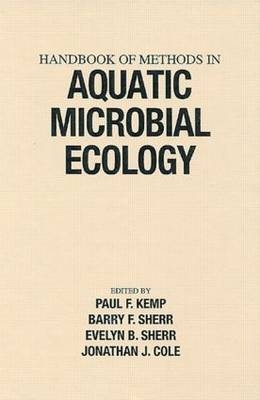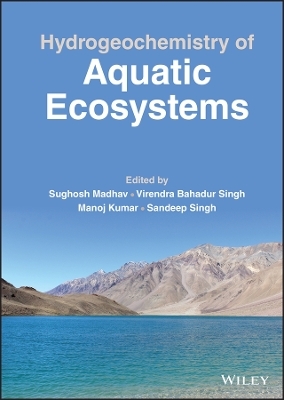
Handbook of Methods in Aquatic Microbial Ecology
Crc Press Inc (Verlag)
978-0-87371-564-5 (ISBN)
Handbook of Methods in Aquatic Microbial Ecology is the first comprehensive compilation of 85 fundamental methods in modern aquatic microbial ecology. Each method is presented in a detailed, step-by-step format that allows readers to adopt new methods with little difficulty. The methods represent the state of the art, and many have become standard procedures in microbial research and environmental assessment. The book also presents practical advice on how to apply the methods. It will be an indispensable reference for marine and freshwater research laboratories, environmental assessment laboratories, and industrial research labs concerned with microbial measurements in water.
Kemp/, Paul F.; Cole/, Jonathan J.; Sherr/, Barry F.; Sherr/, Evelyn B.
Introduction Section I: Isolation of Living Cells 1. Isolation and Enumeration of Anaerobic and Microaerophiiic Bacteria in Aquatic Habitats 2. Isolation and Cultivation of Hyperthermophilic Bacteria from Marine and Freshwater Habitats 3. Isolation of Psychrophilic Bacteria 4. Isolation and Characterization of Bacteriocytes from a Bivalve-Sulfur Bacterium Symbiosis 5. General Techniques for the Isolation and Culture of Marine Protists from Estuarine, Littoral, Psammolittoral, and Sublittoral Waters 6. Long-Term Culture of Marine Benthic Protists 7. Behavior and Bioenergetics of Anaerobic and Microaerobic Protists 8. Culturing Free-Living Marine Phagotrophic Dinoflagellates 9. Enrichment, Isolation, and Culture of Free-Living Heterotrophic Flagellates 10. Determination of Pressure Effects on Flagellates Isolated from Surface Waters 11. Isolation, Cloning, and Axenic Cultivation of Marine Cilliates 12. Isolation and Laboratory Culture of Marine Oligotrichous Ciliates 13. Extraction of Protists in Aquatic Sediments via Density Gradient Centrifugation Section II. Identification, Enumeration, and Diversity 14. Statistical Analysis of Direct Counts of Microbial Abundance 15. Enumeration and Isolation of Viruses 16. Total Count of Viruses in Aquatic Environments 17. Improved Sample Preparation for Enumeration of Aggregated Aquatic Substrate Bacteria 18. Direct Estimates of Bacterial Numbers in Seawater Samples Without Incurring Cell Loss Due to Sample Storage 19. Total and Specific Bacterial Counts by Simultaneous Staining with DAPI and Fluorochrome-Labeled Antibodies 20. Use of RFLPs for the Comparison of Marine Cyanobacteria 21. Use of High-Resolution Flow Cytometry to Determine the Activity and Distribution of Aquatic Bacteria 22. Phytoplankton Analysis Using Flow Cytometry 23. Enumeration of Phototrophic Picoplankton by Autofluorescence Microscopy 24. Estimating Cell Concentration and Biomass of Autotrophic Plankton Using Microscopy 25. Preservation and Storage of Samples for Enumeration of Heterotrophic Protists 26. Staining of Heterotrophic Protists for Visualization via Epifluorescence Microscopy 27. A Quantitative Protargol Stain (QPS) for Ciliates and Other Protists 28. Preparation of Pelagic Protists for Electron Microscopy 29. A Rapid Technique for the Taxonomy of Methanogenic Bacteria: Comparison of the Methylreductase Subunits 30. Extraction of DNA from Soils and Sediments 31. Detecting Gene Sequences Using the Polymerase Chain Reaction 32. Quantitative Description of Microbial Communities Using Lipid Analysis 33. Single-Cell Identification Using Fluorescently Labeled, Ribosomal RNA-Specific Probes 34. Immunofluorescence Method for the Detection and Characterization of Marine Microbes Section III: Biomass 35. The Relationship Between Biomass and Volume of Bacteria 36. Microscope Methods for Measuring Bacterial Biovolume: Epifluorescence Microscopy, Scanning Electron Microscopy, and Transmission Electron Microscopy 37. Measurement of Carbon and Nitrogen Biomass and Biovolume from Naturally Derived Marine Bacterioplankton 38. Use of Color Image Analysis and Epifluorescence Microscopy to Measure Plankton Biomass 39. Determination of Size and Morphology of Aquatic Bacteria by Automated Image Analysis 40. Analysis of Microbial Lipids to Determine Biomass and Detect the Response of Sedimentary Microorganisms to Disturbance 41. Total Microbial Biomass Estimation Derived from the Measurement of Particulate Adenosine-5'-Triphosphate 42. Microphytobenthic Biomass Measurement Using HPLC and Conventional Pigment Analysis 43. Microphotometric Analysis of the Spectral Absorption and Fluorescence of Individual Phytoplankton Cells and Detrital Matter 44. Measurement of Elemental Content and Dry Weight of Single Cells: X-Ray Microanalysis Section IV: Activity, Respiration, and Growth 45. Microautoradiographic Detection of Microbial Activity 46. 14C Tracer Method for Measuring Microbial Activity in Deep-Sea Sediments 47. Evaluating Bacterial Activity from Cell-Specific Ribosomal RNA Content Measured with Oligonucleotide Probes 48. Use of Fluorogenic Model Substrates for Extracellular Enzyme Activity (EEA) Measurement of Bacteria 49. Photoassimilation of Acetate by Algae 50. Starvation-Survival Strategies in Bacteria 51. Community Respiration IVIeasurements Using a Pulsed O Electrode 52. Sediment Community Production and Respiration Measurements: The Use of Microelectrodes and Bell Jars 53. Distinguishing Bacterial from Nonbacterial Decomposition of Spartina alterniflora by Respirometry 54. Microbial RNA and DNA Synthesis Derived from the Assimilation of [2, 3H]-Adenine 55. Adenosine Triphosphate (ATP) and Total Adenine Nucleotide (TAN) Pool Turnover Rates as Measures of Energy Flux and Specific Growth Rate in Natural Populations of Microorganisms 56. Estimating Production of Heterotrophic Bacterioplankton via Incorporation of Tritiated Thymidine 57. Thymidine Incorporation into DNA as an Estimate of Sediment Bacterial Production 58. Leucine Incorporation as a Measure of Biomass Production by Heterotrophic Bacteria 59. Estimating Conversion Factors for the Thymidine and Leucine Methods for Measuring Bacterial Production 60. Bacterial Production in Anaerobic Water Columns 61. Production of Heterotrophic Bacteria Inhabiting Marine Snow 62. Bacterial Growth Rates Measured by Pulse Labeling 63. Utilization of Amino Acids and Precursors for Amino Acid De Novo Synthesis by Planktonic Bacteria 64. Dialysis Bag Incubation as a Nonradiolabeling Technique to Estimate Bacterioplankton Production In Situ 65. Growth Rates of Natural Populations of Heterotrophic Nanoplankton 66. The Labeled Chlorophyll a Technique for Determining Photoautotrophic Carbon Specific Growth Rates and Carbon Biomass 67. Incorporation of 14CO2 into Protein as an Estimate of Phytoplankton N-Assimilation and Relative Growth Rate 68. Membrane-Containing Fungal Mass and Fungal Specific Growth Rate in Natural Samples Section V: Organic Matter Decomposition and Nutrient Regeneration 69. Radiotracer Approaches for the Study of Plant Polymer Biodegradation 70. Estimating Degradation Rates of Chitin in Aquatic Samples 71. Measurement of Dimethylsulfide (DMS) and Dimethylsulfoniopropionate (DMSP) in Seawater and Estimation of DMS Turnover Rates 72. Sulfate Assimilation by Aquatic Microorganisms 73. Determination of Nitrogenase Activity in Aquatic Samples Using the Acetylene Reduction Procedure 74. Denitrification and Nitrification Rates in Aquatic Sediments 75. Turnover of 15NH4+ Tracer in Sediments 76. Microbial Cycling of Inorganic and Organic Phosphorus in the Water Column Section VI: Food Webs and Trophic Interactions 77. Approaches for Measuring Stable Carbon and Nitrogen Isotopes in Bacteria 78. Bacterial Sinking Losses 79. Methods for the Observation and Use in Feeding Experiments of Microbial Exopolymers 80. Protistan Grazing Rates via Uptake of Fluorescently Labeied Prey 81. Grazing Rate of Bacterioplankton via Turnover of Genetically Marked Minicells 82. Estimating Rates of Growth and Grazing Mortality of Phytoplanlcton by the Dilution Method 83. Consumption of Protozoa by Copepods Feeding on Natural Microplankton Assemblages 84. Predation on Planktonic Protists Assessed by Immunochemical Assays 85. Absorption of Microbes by Benthic Macrofauna by the 14C:51Cr Dual-Labeling Method 86. Radioisotope Technique to Quantify In Situ Microbivory by Meiofauna in Sediments
| Erscheint lt. Verlag | 28.6.1993 |
|---|---|
| Zusatzinfo | 19 Tables, black and white; 15 Halftones, black and white |
| Verlagsort | Bosa Roca |
| Sprache | englisch |
| Maße | 178 x 254 mm |
| Gewicht | 1640 g |
| Einbandart | gebunden |
| Themenwelt | Naturwissenschaften ► Biologie ► Limnologie / Meeresbiologie |
| Naturwissenschaften ► Biologie ► Mikrobiologie / Immunologie | |
| ISBN-10 | 0-87371-564-0 / 0873715640 |
| ISBN-13 | 978-0-87371-564-5 / 9780873715645 |
| Zustand | Neuware |
| Haben Sie eine Frage zum Produkt? |
aus dem Bereich


